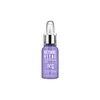What's inside
What's inside
 Key Ingredients
Key Ingredients

No key ingredients
 Benefits
Benefits

 Concerns
Concerns

No concerns
 Ingredients Side-by-side
Ingredients Side-by-side

Water
Skin ConditioningButylene Glycol
HumectantGlycerin
HumectantNiacinamide
SmoothingGlycereth-26
HumectantDimethicone
EmollientBenzyl Glycol
SolventSorbitan Sesquioleate
EmulsifyingBetaine
HumectantPolyglyceryl-4 Caprate
EmulsifyingArginine
MaskingCarbomer
Emulsion StabilisingParfum
MaskingTocopheryl Acetate
AntioxidantTrehalose
HumectantPanthenol
Skin ConditioningChlorphenesin
Antimicrobial1,2-Hexanediol
Skin ConditioningGlyceryl Acrylate/Acrylic Acid Copolymer
HumectantXanthan Gum
EmulsifyingAdenosine
Skin ConditioningDisodium EDTA
Sodium Hyaluronate
HumectantNelumbo Nucifera Phytoplacenta Culture Extract
AntimicrobialDipropylene Glycol
HumectantEthylhexylglycerin
Skin ConditioningPvm/Ma Copolymer
Emulsion StabilisingPEG-35 Castor Oil
EmulsifyingCitrus Limon Fruit Extract
MaskingAlcohol
AntimicrobialHydrogenated Phosphatidylcholine
EmulsifyingAesculus Hippocastanum Seed Extract
Skin ConditioningMacadamia Ternifolia Seed Oil
EmollientCaprylic/Capric Triglyceride
MaskingPolysorbate 20
EmulsifyingHydrogenated Lecithin
EmulsifyingSodium PCA
HumectantSerine
MaskingRetinol
Skin ConditioningTremella Fuciformis Sporocarp Extract
AntioxidantTocopherol
AntioxidantGlycine
BufferingCholesterol
EmollientCeramide NP
Skin ConditioningAlanine
MaskingBrassica Campestris Sterols
EmollientGlutamic Acid
HumectantCeteth-5
EmulsifyingCeteth-3
EmulsifyingInositol
HumectantRetinyl Palmitate
Skin ConditioningCalcium Pantothenate
Potassium Cetyl Phosphate
EmulsifyingLinoleic Acid
CleansingSucrose Stearate
EmollientStearic Acid
CleansingPhytosphingosine
Skin ConditioningPalmitic Acid
EmollientGlycosphingolipids
EmollientBiotin
AntiseborrhoeicWater, Butylene Glycol, Glycerin, Niacinamide, Glycereth-26, Dimethicone, Benzyl Glycol, Sorbitan Sesquioleate, Betaine, Polyglyceryl-4 Caprate, Arginine, Carbomer, Parfum, Tocopheryl Acetate, Trehalose, Panthenol, Chlorphenesin, 1,2-Hexanediol, Glyceryl Acrylate/Acrylic Acid Copolymer, Xanthan Gum, Adenosine, Disodium EDTA, Sodium Hyaluronate, Nelumbo Nucifera Phytoplacenta Culture Extract, Dipropylene Glycol, Ethylhexylglycerin, Pvm/Ma Copolymer, PEG-35 Castor Oil, Citrus Limon Fruit Extract, Alcohol, Hydrogenated Phosphatidylcholine, Aesculus Hippocastanum Seed Extract, Macadamia Ternifolia Seed Oil, Caprylic/Capric Triglyceride, Polysorbate 20, Hydrogenated Lecithin, Sodium PCA, Serine, Retinol, Tremella Fuciformis Sporocarp Extract, Tocopherol, Glycine, Cholesterol, Ceramide NP, Alanine, Brassica Campestris Sterols, Glutamic Acid, Ceteth-5, Ceteth-3, Inositol, Retinyl Palmitate, Calcium Pantothenate, Potassium Cetyl Phosphate, Linoleic Acid, Sucrose Stearate, Stearic Acid, Phytosphingosine, Palmitic Acid, Glycosphingolipids, Biotin
 Reviews
Reviews

Ingredients Explained
These ingredients are found in both products.
Ingredients higher up in an ingredient list are typically present in a larger amount.
1,2-Hexanediol is a synthetic liquid and another multi-functional powerhouse.
It is a:
- Humectant, drawing moisture into the skin
- Emollient, helping to soften skin
- Solvent, dispersing and stabilizing formulas
- Preservative booster, enhancing the antimicrobial activity of other preservatives
Butylene Glycol (or BG) is used within cosmetic products for a few different reasons:
Overall, Butylene Glycol is a safe and well-rounded ingredient that works well with other ingredients.
Though this ingredient works well with most skin types, some people with sensitive skin may experience a reaction such as allergic rashes, closed comedones, or itchiness.
Learn more about Butylene GlycolEthylhexylglycerin (we can't pronounce this either) is commonly used as a preservative and skin softener. It is derived from glyceryl.
You might see Ethylhexylglycerin often paired with other preservatives such as phenoxyethanol. Ethylhexylglycerin has been found to increase the effectiveness of these other preservatives.
Glycerin is already naturally found in your skin. It helps moisturize and protect your skin.
A study from 2016 found glycerin to be more effective as a humectant than AHAs and hyaluronic acid.
As a humectant, it helps the skin stay hydrated by pulling moisture to your skin. The low molecular weight of glycerin allows it to pull moisture into the deeper layers of your skin.
Hydrated skin improves your skin barrier; Your skin barrier helps protect against irritants and bacteria.
Glycerin has also been found to have antimicrobial and antiviral properties. Due to these properties, glycerin is often used in wound and burn treatments.
In cosmetics, glycerin is usually derived from plants such as soybean or palm. However, it can also be sourced from animals, such as tallow or animal fat.
This ingredient is organic, colorless, odorless, and non-toxic.
Glycerin is the name for this ingredient in American English. British English uses Glycerol/Glycerine.
Learn more about GlycerinWater. It's the most common cosmetic ingredient of all. You'll usually see it at the top of ingredient lists, meaning that it makes up the largest part of the product.
So why is it so popular? Water most often acts as a solvent - this means that it helps dissolve other ingredients into the formulation.
You'll also recognize water as that liquid we all need to stay alive. If you see this, drink a glass of water. Stay hydrated!
Learn more about Water